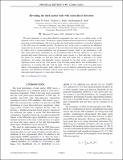| dc.contributor.author | Foster, Joshua W. | |
| dc.contributor.author | Safdi, Benjamin R. | |
| dc.contributor.author | Rodd, Nicholas Llewellyn | |
| dc.date.accessioned | 2018-06-20T13:34:24Z | |
| dc.date.available | 2018-06-20T13:34:24Z | |
| dc.date.issued | 2018-06 | |
| dc.date.submitted | 2018-01 | |
| dc.identifier.issn | 2470-0010 | |
| dc.identifier.issn | 2470-0029 | |
| dc.identifier.uri | http://hdl.handle.net/1721.1/116445 | |
| dc.description.abstract | The next generation of axion direct-detection experiments may rule out or confirm axions as the dominant source of dark matter. We develop a general likelihood-based framework for studying the time-series data at such experiments, with a focus on the role of dark matter astrophysics, to search for signatures of the QCD axion or axionlike particles. We illustrate how in the event of a detection the likelihood framework may be used to extract measures of the local dark matter phase-space distribution, accounting for effects such as annual modulation and gravitational focusing, which is the perturbation to the dark matter phase-space distribution by the gravitational field of the Sun. Moreover, we show how potential dark matter substructure, such as cold dark matter streams or a thick dark disk, could impact the signal. For example, we find that when the bulk dark matter halo is detected at 5σ global significance, the unique time-dependent features imprinted by the dark matter component of the Sagittarius stream, even if only a few percent of the local dark matter density, may be detectable at ∼2σ significance. A corotating dark disk, with lag speed ∼50 km/s, that is ∼20% of the local dark matter density could dominate the signal, while colder but as-of-yet unknown substructure may be even more important. Our likelihood formalism, and the results derived with it, are generally applicable to any time-series-based approach to axion direct detection. | en_US |
| dc.description.sponsorship | United States. Department of Energy (Grant DESC00012567) | en_US |
| dc.description.sponsorship | United States. Department of Energy (Grant DE-SC0013999) | en_US |
| dc.publisher | American Physical Society | en_US |
| dc.relation.isversionof | http://dx.doi.org/10.1103/PhysRevD.97.123006 | en_US |
| dc.rights | Article is made available in accordance with the publisher's policy and may be subject to US copyright law. Please refer to the publisher's site for terms of use. | en_US |
| dc.source | American Physical Society | en_US |
| dc.title | Revealing the dark matter halo with axion direct detection | en_US |
| dc.type | Article | en_US |
| dc.identifier.citation | Foster, Joshua W. et al. "Revealing the dark matter halo with axion direct detection." Physical Review D 81, 5 (March 2010): 052006 © 2010 American Physical Society | en_US |
| dc.contributor.department | Massachusetts Institute of Technology. Center for Theoretical Physics | en_US |
| dc.contributor.mitauthor | Rodd, Nicholas Llewellyn | |
| dc.relation.journal | Physical Review D | en_US |
| dc.eprint.version | Final published version | en_US |
| dc.type.uri | http://purl.org/eprint/type/JournalArticle | en_US |
| eprint.status | http://purl.org/eprint/status/PeerReviewed | en_US |
| dc.date.updated | 2018-06-15T18:00:39Z | |
| dc.language.rfc3066 | en | |
| dc.rights.holder | American Physical Society | |
| dspace.orderedauthors | Foster, Joshua W.; Rodd, Nicholas L.; Safdi, Benjamin R. | en_US |
| dspace.embargo.terms | N | en_US |
| dc.identifier.orcid | https://orcid.org/0000-0003-3472-7606 | |
| mit.license | PUBLISHER_POLICY | en_US |
